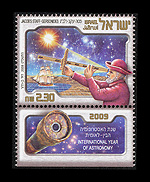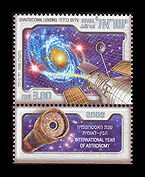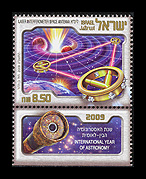|
|
The year 2009 has been designated by the International Astronomical Union and UNESCO as the International Year of Astronomy, marking the 400th anniversary of the invention of the astronomical telescope by Galileo Galilei – the first person to turn a research telescope toward the sky, opening new horizons for scientists and expanding the boundaries of the known universe.
This stamp series displays three milestones in the field of astronomical measuring which greatly impact our understanding of the universe.
Jacob’s Staff - Gersonides
The study and mapping of the heavens began before Galileo, with the Jewish people making a unique contribution in the form of “Jacob’s Staff” – an ancient measurement tool for mapping stars, which was first described and in all likelihood invented by Gersonides (Rabbi Levi ben Gershon, France, 1288-1344). The staff was 1.4 meters long and notched with scale graduations along its length. Up to seven cross-pieces of varying lengths, called “transoms”, slid up and down along the main piece. By aiming one end of the transom toward a star and sliding the transom along the notched main staff until its other end lined up with another star, one could measure the angular distance between those two stars.
Navigators also made use of Jacob’s Staff to measure the altitude of the North Star above the horizon in order to determine their latitude.
![]() top
top
Gravitational Lensing
Over the years, telescopes have become a powerful research tool, and the largest among them are equipped with concave mirrors measuring 8-10 meters in diameter. The larger the mirror, the more light it captures, allowing the measurement of fainter astronomical bodies. Mirrors measuring 40 meters in diameter and more are planned for the future. But the universe’s largest telescopes are those that exist in nature. The way in which they work was discovered by the Jewish scientist Albert Einstein, one of the most significant scientists of all time.
One of his revolutionary breakthroughs in the field of physics is the General Theory of Relativity, dealing with space and time in nature. According to this theory, as light rays from a distant astronomical body pass by a massive object, the object’s gravitational force affects their paths and they bend. Thus, a massive body that is positioned between an observer and a distant astronomical body acts as a lens – the distant body appears enlarged and may even be multiplied, as a number of images appear alongside the “lens”. The phenomenon of light rays changing course due to gravitational force is called “Gravitational Lensing”. Gravitational lenses may be created by regular stars or by more dense astronomical bodies such as black holes, by galaxies or even by clusters of galaxies. Nature’s largest telescopes allow us to glimpse distant galaxies and perceive light that was emitted from them more than ten billion years ago. Today, the largest ground and space telescopes photograph images of extremely distant astronomical bodies after they have undergone gravitational lensing.
![]() top
top
LISA – Laser Interferometer Space Antenna
In the future, new astronomical research fields involving the examination of radiation in spectral regions that have yet to be studied will develop. One example of this is gravitational radiation. Although its existence may be derived from Einstein’s General Theory of Gravity, no one has been able to detect it as yet. The future LISA system, which will comprise three spacecraft arranged at the apices of an equilateral triangle and connected by laser beams, is currently being planned to detect and measure gravitational waves. Gravitational waves warp the space surrounding the spacecraft and as a result the spacecraft will move farther away from or closer toward each other. Each pair of spacecraft will be spaced five million kilometers apart. Any miniscule change of up to one millionth of a centimeter in the length of one of the sides of the huge triangle will be measured by the laser beams emanating from the spacecraft, revealing the existence of a gravitational wave.
Astrophysics research groups are active at most of Israel’s universities. Tel-Aviv University operates a research observatory in Mitzpe Ramon and hundreds of astronomy enthusiasts, some of whom are members of the Israeli Astronomical Association, observe the skies through private telescopes and from the amateur observatories located throughout the country.
Dr. Noah Brosch
Director, the Florence and George Wise Observatory
Tel-Aviv University



